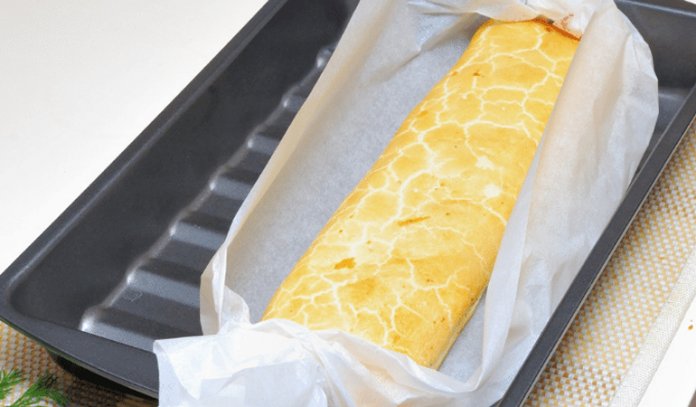Keeping your pantry stocked with the right type of baking pans can be confusing because there are thousands of options out there.
Making things worse is the fact that some manufacturers apply the same label to all pan sizes and variants – probably make for easier packaging – none of which helps our case.
Contents
Using the right pan size is a precursor to a perfectly cooked cake.
What is a Jelly Roll Pan?
Every now and then you’ll find recipes referring to ‘jelly roll pans’ if you want to cook them for perfection.
A jelly roll pan is a variation of the rectangular sheet pan with 1 inch deep sides, you could argue that it is the smaller variant of a half-sheet pan.
It is designed to bake sheet cakes or thin sponges that are thick enough to fill with jelly or crème and roll into a cylindrical shape. These pans are made of various materials including aluminum and steel.
The pans are named after a dish that often can’t be perfected without them: the jelly roll (or Swiss roll cake).
Baking recipes that specifically ask for a jelly roll pan, including the jelly roll, cannot be easily adapted to another pan.
The most popular sizes used in recipes and cakes is 10 by 15 inches, but you will find larger sizes as well.
The two most dominant non-commercial jelly roll pans have the following dimensions;
- Sheet pan (regular sized): 10 1/2” wide by 15 1/2” long by 1” depth – can hold 10 cups
- Sheet pan (large-sized): 12 1/2” wide by 17 1/2” long by 1” deep – can hold 12 cups
Best Substitutes for Jelly Roll Pan
This brings us to an important question: is there a substitute for a jelly roll pan?
The answer boils down to your specific requirements. A jelly roll (or the Swiss roll), for instance, can and should only be tried on a jelly roll pan.
Most baking pans can fill in nicely for jelly roll pans, just make sure they have 1-inch edges otherwise the cake won’t hold its shape.
Is There a Difference Between Cookie Sheets and Jelly Roll Pans?
You’ll notice that cookie sheets and jelly roll pans look extremely similar and share the same dimensions; however, there is one very major difference between the two.
In the case of cookie sheets, they have one or two sides bent for easier handling. The construction allows air to properly flow around the cookies as they properly bake.
A jelly roll pan has a 1-inch lip around the edges that make it easier to cook jelly rolls. The task of cookie sheets is to bake cookies evenly and prevent browning and crisp bottoms or edges – that’s all there is to them.
In most cases, jelly roll pans and cookie sheets can be used interchangeably. However, you cannot substitute them if you are baking a finicky dish that calls for the specific qualities of a jelly roll pan.
For example, you cannot cook the jelly roll on a cookie sheet. However, a jelly roll pan is used to do many of the same tasks as a cookie sheet without a hitch.
Do keep in mind that the heat flow around the cookies will be slightly different in a jelly roll man compared to a cookie sheet.
Because of this, you will have to adjust the cooking time accordingly – make sure to keep checking in every 5 to 10 minutes earlier than normal if you’re using a jelly roll pan and check to see how they’re baking.
We recommend buying a jelly roll pan because it is the true workhorses of the kitchen. You can use them for tasks like roasting veggies, oven fries, baking cookies, chicken, fish, and nuts – the works.
However, if you have to use the cookie sheet, you’ll have to make up for the lack of the 1-inch lip.
A clever workaround, which is a hit and miss in most cases, is to use an aluminum foil deep enough to keep your recipe from flowing to the bottom of the oven.
If you do it right, it should keep the batter in place and give it the right structure for filling and rolling.
Is a Half Sheet Pan a Good Substitute for Jelly Roll Pan?
Many manufacturers these days refer to just about every other rimmed baking sheet as jelly roll pans – even the half sheet pans, which usually measure 13 by 18 inches.
However, you need the right size or your cake layers will come out to be very thin and may even burn to a crisp. This is a real possibility with a pan of an incompatible size.
Most recipes for jelly roll ask you to fill the jelly roll pan with batter. This results in a cake that is 1” in height and sturdy enough to hold lots of filling.
In the case of the half sheet pan with its wider area, your batter will be spread too thin for you to make any adjustments to the filling.
The jelly roll pan has extremely unique dimensions that are ideal for giving your cake the unique sponge or sheet-like structure to retain shape after filling and rolling.
If you use the real deal, on the other hand, you can bet that the jelly roll will come out looking (and tasting) perfect without any signs of cracking, burning, or crumbling.
But if you don’t mind anything less than perfect, then you should be fine with a half sheet pan as it yields extremely like-for-like results.
Other Good Substitutes for Jelly Roll Pan
The following pans have 1 inch deep sides that are useful for baking most items in the kitchen, including jelly rolls.
Just make sure you don’t accidentally end up buying a cookie sheet pan because some manufacturers are known for freely using the label ‘baking sheet’.
Full Sheet Pan
A full sheet pan measures 26 by 18 inches and features 1-inch sides. The pan is much too big for practical home use, and in most cases, won’t fit home ovens.
Instead, Full Sheet pans are used by caterers and restaurants. The only way we see a full sheet pan being used in a home environment is as an organizing bin for the pantry.
Quarter Sheet
Halving the half-sheet pan results in the quarter-sheet pan.
This smaller pan measures 13 by 9 inches. You can do all of the things that a jelly roll pan can do, except, of course, you’ll be cooking on a smaller scale.
The Half sheet pan is a great option if you don’t have many guests to feed. It’s also a good pan for toaster cooking, drying out ingredients in the refrigerator, organizing, and freezing batches of cookies before placing them in plastic freezer bags.
You can make Jelly rolls, but you should keep in mind that the recipe may be difficult to adapt.
How to Make Jelly Roll Cake
The classic Jelly Roll cake is an impressive dish that will take center stage on any dessert table.
This fluffy cake is rolled around an extraordinary silky frosting, earning it a place of honor on any menu.
But there’s no need to be intimidated by its looks – the technique is easily achievable even by a novice baker, as long as you have the right tools.
Ingredients
- 3 eggs
- 1 cup granulated sugar
- ¼ tbsp salt
- Powdered sugar
- 2/3 jelly or jam
- ¾ cup of all-purpose flour
- 1 tbsp baking powder
- ½ cup of water
- 1 tbsp vanilla
Directions
- You’ll need a pan with a 1-inch edge, a jelly roll pan is a perfect candidate but you can make do with other pans highlighted above.
- Heat the oven to 380°F. Line the pan with waxed paper and apply grease.
- In a medium bowl, toss in eggs and beat them with a mixer on high speed for about 5 minutes or until they look thick or lemon colored. Now add in granulated sugar. Beat in water and vanilla at slow speed. Now add baking powder, salt, and flour to the mixture, gradually beating it until the batter is smooth. Pour it into the pan, spreading to all corners.
- Now bake the cake for about 12 to 15 minutes. Once 15 minutes have passed, immediately remove the cake from the pan’s sides and flip it upside down onto a towel. Carefully remove the foil and towel, starting from the narrow end.
- Dry the cake on cooling air for about 30 minutes.
- Unroll the cake and remove the towel
- Use a fork to spread jelly over the cake. Roll up the cake and sprinkle with powdered sugar.
Pro Tip: You can use an ice cream filling instead of jam. In this case, simply add 1 pint softened ice cream over the cooled cake. Roll up the cake and wrap it in plastic wrap. Freeze for 3 hours or until firm.
Wrapping Up
So there you have it, most baking pans can serve the same purpose as a jelly roll pan as long as they have a 1-inch side.
However, the width and surface area may result in less-than-perfect results, if you’re making jelly rolls and other recipes that specifically demand a jelly roll pan.
Found a substitute for jelly roll pan that we couldn’t? Share your findings with us in the comments below.


